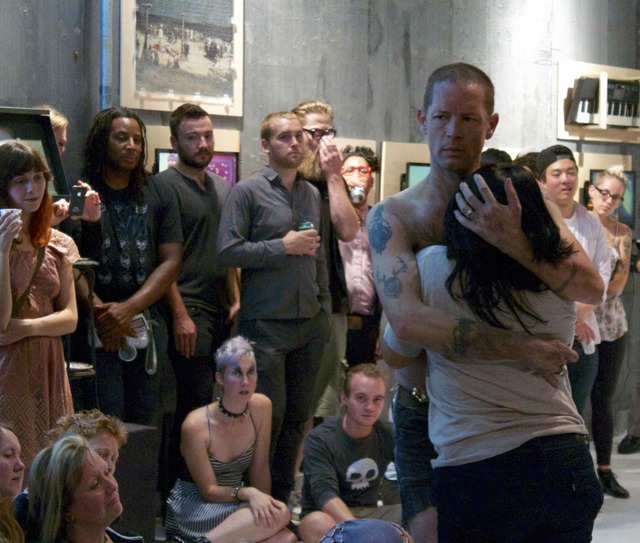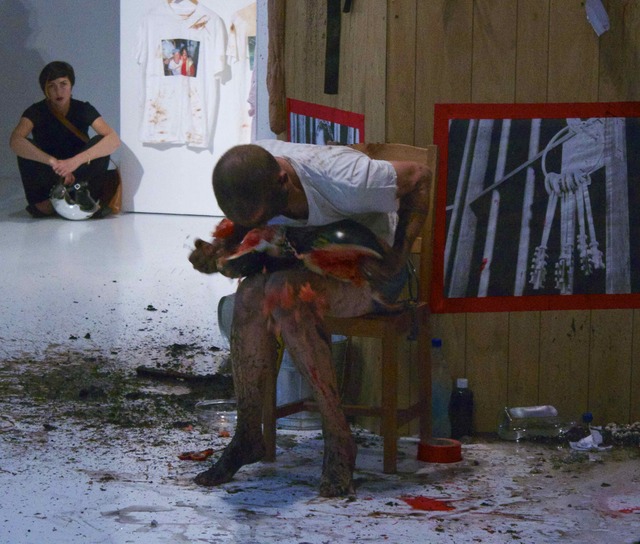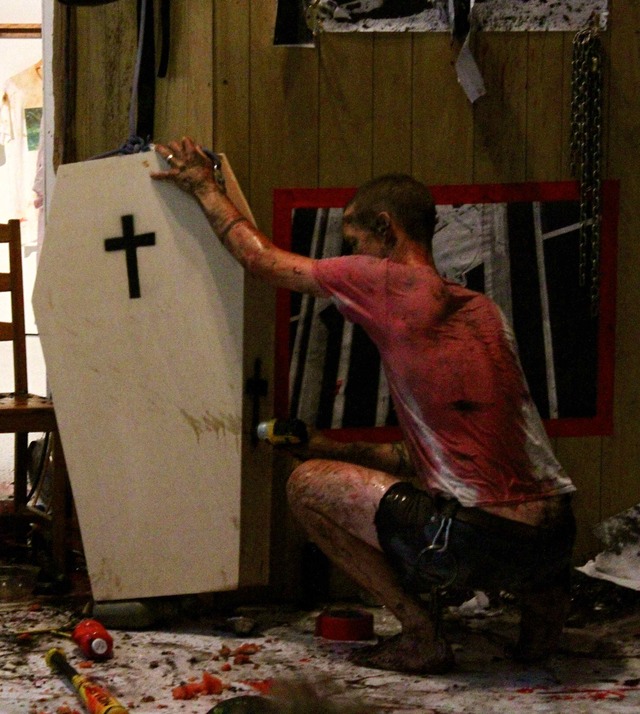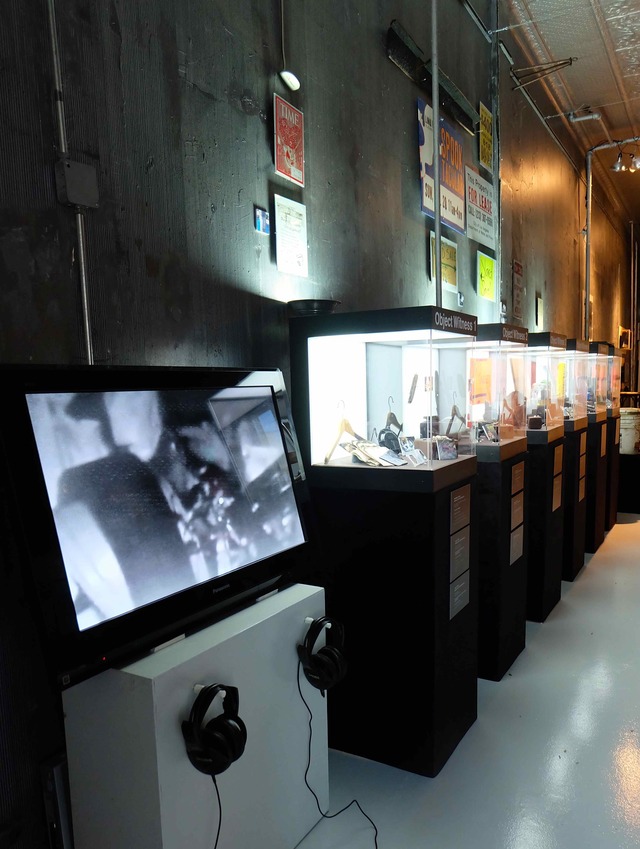Jamie McMurry At Defibrillator: Rage And Vulnerability At Once
By Carrie McGath in Arts & Entertainment on Sep 9, 2014 9:05PM
Jamie McMurry's "Above Snakes" opened with a performance that was aggressive and angry while being vulnerable and deeply human. McMurry presented "Angel Lust" to a very large and engaged audience at Defibrillator Gallery last Friday night. The performance's mood was quite a juxtaposition to the quiet and even somber exhibition that is on view through Saturday, Sept. 13.
Throughout this live work the audience reacted, their bodies reflecting these stark reactions. I felt my eyes shutter and my heart jump in response to watching him strike a picture of Geronimo with a dog chain, and the sound was booming and brutal on the wood paneling where it hung.
The overall performance was a harrowing cocktail of rage-addled sound and destruction tinged at times with slight glimmers of humor executed by momentarily leaving the performance to clear his throat or say "hot pants" into the microphone after cutting up his jeans. The audience continually scooted back from the action unfolding before them, some uncomfortably giggling or sitting still and rendered as speechless as I was.
McMurry's relation to objects is a very large part of his process. When we met before his artist's talk on Saturday morning, he said objects and his relation to them are, in essence, his media as a performer and he must fully understand these things just as a painter would need to understand tempera and oils. The live performance demonstrated his occupation and engagement with objects including trophies, mason jars of beads, a baseball bat and a slingshot made from surgical tubing. These objects relate to his childhood in the small, rural town of Yakima, Washington where violence persisted within a culture that obliged boys to fully embrace and occupy a space that was deemed to be masculinity incarnate, a masculinity steeped in rage and violence.
These objects take on a new meaning in the artist's relation to them, in this case a very biographical relationship. The boyishness of a baseball bat and a slingshot and making a mess with mud and paint become Gothic and telling, with the banality of everyday objects becoming tools of destructive play and telling a story that is colored by his childhood filled with masculine pressures, poverty, and violent tasks such as slaughtering cattle.
Then there is a quiet and soft side to his work with the exhibition that is on display. "Object Witness" is somber and lovely with a humdrum of objects displayed in museum vitrines equipped with an object label and cell phone audio guide, making it a powerful miniature natural history museum. Here, objects that would normally be meaningless—a piece of wood from a tree, a plastic piece from a Volkswagen Jetta, streets signs, a wooden hanger—take on an ominous presence since they were witness to violence.
"It got so surprisingly dark, I had to stop." These are objects McMurry found at the scene after a car accident, a murder, a suicide. This is a project that had to cease, at least for a while, the artist's emotion so entwined with what became the story of each object. "The darkness and the blackness and the trauma contained within these things had a real personal effect over me, a noticeable effect, and it went a little too far." Living these objects' trauma became a part of him and the humanity and the tragedy wore on him in a profoundly deep way.
The cellphone guide gives the overall work a documentary feel making the viewer a witness as well, even a participant, since in listening to the guide, it feels very much like you are with the artist on his way to a scene to retrieve these objects that have bare witness to a violent moment. There is a window of time he has to get to the scenes, too, so there is a palpable urgency in the accompanying recordings as well.
"Crossover" and "The Collection" also covet objects within vitrines. Again, a piece of burned wood, a melted cell phone, and police tape are as typical as the objects from the crime scenes, and again McMurry is working with context and how we view and revere certain objects. These objects, though, are a bit different since they are not as "anonymous" as the ones from the scenes of a homeless man who set himself on fire or an emptied and aging newspaper box with bullet holes when police pursued and shot a mentally ill man after a car chase.
These are relics from our time, recognizable in their narratives. The burned wood shard is from the Waco stand-off and the cellphone belonged to Rolling Stone journalist, Michael Hastings, who was killed in a car crash, and the police tape was put up before the Boston Marathon bombing to keep crowds back during the race. Every object has a story, especially the ones bearing witness to these intense personal and historical tragedies.
The remainder of the exhibit includes a video of the artist teaching himself how to play The Doors' "L.A. Woman" on a keyboard in Jim Morrison's Laurel Canyon neighborhood and a video documenting him doing a jigsaw puzzle of an little-known mural that also graces a wall in the star-studded Forest Lawn Memorial Park cemetery in Los Angeles. T-shirts hang nearby as documentation of performances he has done all over the world and the suits from his "Color Theory" work are on display as well with photographs of these events he never promoted, where the audience was simply whoever was passing by.
This is a markedly unique and riveting solo exhibition by one of the most vital performance artists working today. Defibrillator will be open Monday through Saturday from noon to 5:00 p.m. through Sept. 13 for visitors to see the exhibition. This is an absolute must-see show that is a great beginning to the fall art season in Chicago.
Defibrillator Performance Art Gallery is located at 1136 N. Milwaukee Ave.






